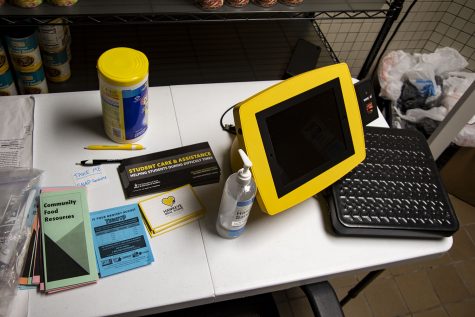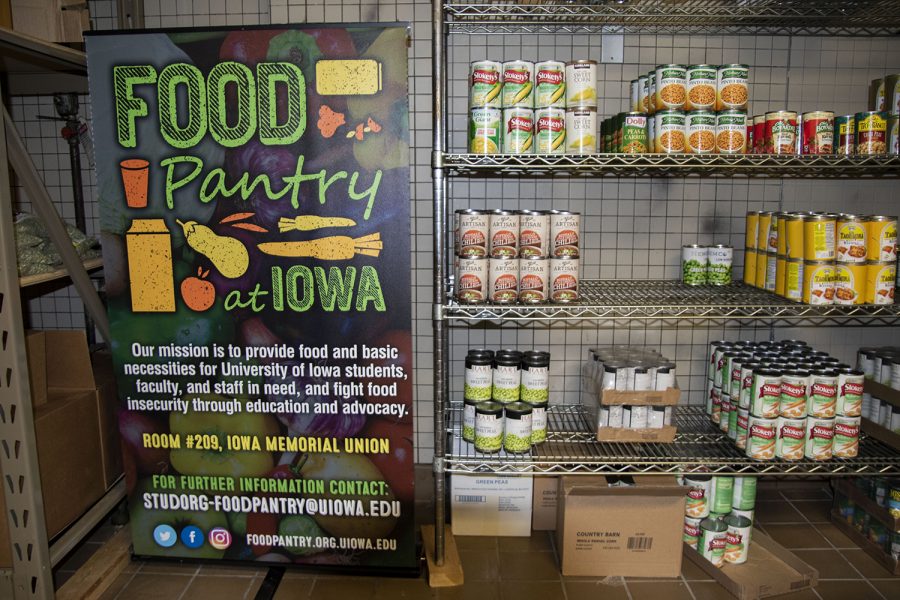Food Pantry at Iowa faces unprecedented demand, volunteers seek additional aid
The Food Pantry at Iowa has struggled to meet high demands for nutritious food for those in need in the UI community, with student volunteers hoping for an increase in funding to restructure, hire a full-time employee, and offer a broader range of products and services.
Can goods slowly fill the shelf at the U of Iowa food pantry, on Friday, Jan 22, 2021.
January 26, 2021
The University of Iowa Food Pantry, a student-run organization, is seeking additional funding from the university after it experienced an unprecedented increase in demand in 2020.
The Food Pantry at Iowa distributed over 32,000 pounds of food during the fall 2020 semester, over four times the amount of food distributed during the same time period in 2019.
More than 300 clients used the food pantry this fall, of which nearly a third were university employees. The reach of and demand for the pantry outside of the student population, advocates say is a sign it’s outgrowing its student organization status. Thirty percent of patrons were university employees, 42 percent undergraduates, 23 percent graduate students, and 5 percent professional students.
The Food Pantry at Iowa is currently a student organization, advised by Sarah Henry, the AmeriCorps Civic Engagement program coordinator in the Office of Leadership, Service, and Civic Engagement. Henry also advises the Clothing Closet, a campus organization that offers free professional wear to students.
UI junior and psychology major Manisha Modukuri stepped into the position of executive director at the food pantry after UI senior Charlotte Lenkaitis, Global Health Studies and Spanish major, ended her term at the end of 2020.
Undergraduate Student Government granted the Food Pantry at Iowa a significant amount of surplus funding, but Lenkaitis and Modukuri said they’re seeking additional assistance in order to restructure the food pantry.
The Food Pantry at Iowa’s executive board is in the process of writing a proposal to get more funding from the UI Division of Student Life, Lenkaitis said, which is expected to come up for discussion around March.
“This past year was a challenging time with the pandemic, trying to change how we do food distribution,” Lenkaitis said. “We are seeing more clients now than we have ever seen in the past. How the food pantry is structured now … it’s not sustainable. I’ve been in tears over how much work there is to do for the food pantry. We’re looking to get a full time, permanent staff member assigned to help with day-to-day operations.”
Associate Vice President and Dean of Students Angie Reams said the division looks forward to receiving and reviewing the proposal, and the division leadership is “dedicated to supporting” the pantry’s initiatives.
“The Division of Student Life fully supports the student leadership of the Food Pantry and appreciates the long-standing work of the student organization,” Reams said in a prepared statement emailed to The Daily Iowan. “The division believes in honoring the students who began the Food Pantry and those students who continue to lead. Leadership in the division is dedicated to supporting the initiatives of the Food Pantry at Iowa as well as supporting overall student wellbeing and basic needs in variety of ways through student organizations, resources, and focused committee work.”
Assistant Professor of Educational Policy & Leadership Studies Katharine Broton, co-editor of the book Food Insecurity on Campus: Action and Intervention, wrote in an email to the DI that the client demographics at the food pantry are indicative of a broader issue in the UI community.
“Most clients visit the pantry once or twice to get through a rough patch, but about 20 percent visit five or more times, suggesting a more serious problem with food insecurity,” Broton said. “The COVID-19 pandemic has exacerbated food insecurity across the world, and our campus is no different. The additional federal investments in SNAP and through the CARES Act have helped, but it is not enough to meet the growing demand.”
The Hawkeye Area Community Action Program provides about 70 percent of the food donations to the Food Pantry at Iowa.
The Food Pantry at Iowa has also partnered with Table to Table, an organization that acts as a middleman to collect donations of edible food from restaurants, grocery stores, and even school cafeterias that would otherwise be thrown away.
Lenkaitis said Table to Table brings donations to the food pantry about once a week, and food pantry volunteers make weekly shopping trips for non-food items and staples not always available via donations.
According to the Food Pantry at Iowa’s website, Table to Table donated 13.2 percent of the food in December.
The Food Pantry at Iowa has a list of high priorities, one of which is providing a more diverse range of ingredients, Modukuri said.
“When you are able to provide a greater range of culturally diverse foods, it shows more recognition for the clients,” Modukuri said. “Regardless of your culture, you should be able to come into the pantry and get the items you want.”

Lenkaitis said the Food Pantry at Iowa also offers toiletry items such as menstrual products, toilet paper, toothbrushes, toothpaste, and occasionally diapers.
“We like to provide that steady, stable supply of hygiene items, but it’s often difficult because they’re much more expensive for us to purchase, and we don’t usually get donations of them,” Lenkaitis said.
Lenkaitis and Modukuri said the Food Pantry at Iowa executive board hopes to expand its repertoire of non-food items to include kitchen items like dish soap, aluminum foil, and even pots and pans.
Inspired by the Human Services Resource Center at Oregon State University, Lenkaitis said she dreams of having a space where students in need can eat, rest, take showers, or even use a free washer and dryer. While calling it a lofty goal, she said expanding the food pantry beyond a student organization could be a good first step.
Modukuri, who began volunteering with the food pantry as a freshman, said the most beneficial thing to the food pantry would be awareness.
“Food insecurity is an issue on college campuses,” she said, “… and food pantries aren’t going to solve it.”
Broton agreed and said operating the food pantry was not enough.
“We need to get hungry students food to eat today through pantries, meal vouchers, emergency aid, and so on. We can also help prevent them from becoming hungry by connecting them to SNAP and other public benefits,” Broton said. “But ultimately, we need to change policies and systems to keep students from becoming hungry in the first place.






